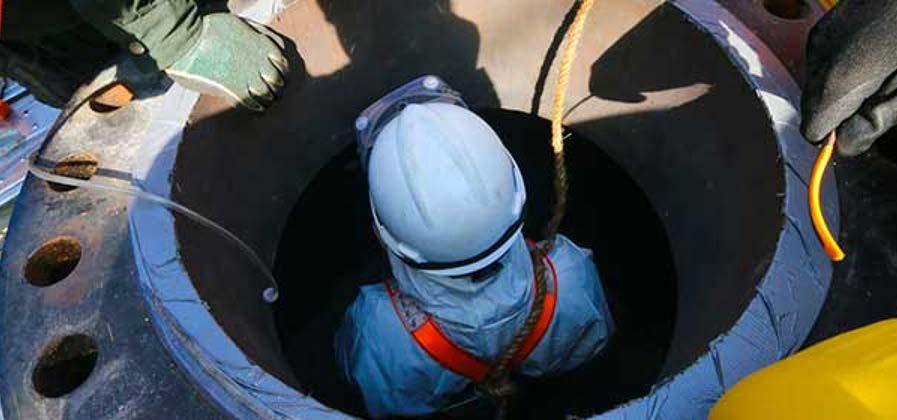
3 minute read
Minimizing COVID-19 Exposure In The Workplace National Safety Compliance | 04.13.2020
ARE YOU TAKING THESE PRECAUTIONS TO HELP WORKERS STAY SAFE DURING THE CORONAVIRUS PANDEMIC?
There are thousands of workplaces still operating – many at peak capacity – during the coronavirus pandemic. These include food production facilities, warehouses, shipping companies, hospitals, physician offices and factories producing much-needed medical equipment like ventilators and protective masks. Many others are looking at what practices to implement when they return to work from the COVID-19 Pandemic.
Here are some COVID-19 best practices and training tips that will help mitigate risk factors in your workplace. If you already have a robust pandemic safety and training program, these recommendations can make it even stronger.
WHAT IS COVID-19?
Coronavirus Disease 2019 (COVID-19) is a respiratory disease caused by the SARS-CoV-2 virus. As of April 14th, it has already infected more than 588,300 people in the U.S., causing nearly 25,000 deaths.
Some business owners already have pandemic safety training plans in place for influenza outbreaks, but this crisis requires additional COVID-19 safety training in accordance with labor law best practices for coronavirus safety.
SYMPTOMS OF COVID-19
The most common symptoms are fever, cough, and shortness of breath. But an estimated 25% (perhaps even more) of infected people may not exhibit any symptoms at all. These people can nonetheless still spread the disease.
According to the CDC, symptoms of COVID-19 may appear in as few as 2 days or as long as 14 days after exposure.
HOW COVID-19 SPREADS
People can get COVID-19 by being in close proximity to an active carrier or by touching a surface that has the virus on it, then touching their mouth, nose or eyes.
IMPACT ON THE WORKPLACE
The potential for workplace coronavirus is already having these effects on businesses across America:
Greater absenteeism – Some workers can’t report because they have the illness, while others are caregivers for children in locations where schools and daycare centers have been closed.
Reduced or altered hours – Some businesses (like grocery stores) are reducing hours of operation so that facilities can be sanitized overnight.
THE IMPORTANCE OF COMMUNICATION
American workers are both frightened and confused by the COVID-19 pandemic. Company-wide communication can bring calm and clarity. For example, The Department of Labor has created a fact sheet about the Families First Coronavirus Response Act that gives all federal workers greater paid sick leave and expanded family and medical leave during the COVID-19 crisis.

ESTABLISHING A RESPONSE PLAN
If your organization doesn’t currently have an infectious disease preparedness plan, now is the time to implement one. Pandemic training can help business owners and managers deal with the current outbreak and any future ones.
Key considerations include:
Determining where and how workers might get exposed to COVID-19 at your site
Assessing your workers’ risk factors (e.g., age, chronic health conditions, pregnancy, etc.)
Discovering whether coronavirus handwashing best practices are being followed
Developing a plan for higher rates of worker absenteeism
Determining which employees have the ability to work remotely Cross-training employees to cover the duties of those who are ill or providing childcare
PREVENTIVE MEASURES TO MINIMIZE INFECTION
These recommendations can greatly reduce the rate of infection:
Advise employees to stay home if they’re feeling ill
Provide all employees with places to wash their hands with soap and hot water
Train workers in cough and sneeze etiquette (covering a cough or sneeze to prevent airborne transmission)
Distribute hand sanitizers at numerous locations in the workplace
Reorganize workflow to allow for social distancing of six feet between workers
Use disinfectant products to frequently clean desktops, work areas, computer keyboards, etc.
Discourage employees for using other workers’ computers or tools
Encourage employees to wear gloves, protective face masks or bandanas if appropriate
MODIFYING THE WORKPLACE
Infection rates can also be reduced by augmenting the workplace with:
High-efficiency air filters
Sneeze guards
Drive-through windows for customer service
ADDITIONAL RESOURCES ON COVID-19 EXPOSURE IN THE WORKPLACE
The U.S. Department of Health and Human Services’ Centers for Disease Control and Prevention (CDC) provides the latest information about COVID-19: www.cdc.gov/ coronavirus/2019-ncov.
The Occupational Safety and Health Administration (OSHA) also provides COVID-19 updates at www.osha.gov/SLTC/ covid-19/.







